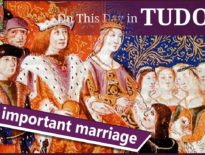On this day in Tudor history, 18th October 1555, Elizabeth, daughter of Henry VIII and Anne Boleyn, finally received permission from her half-sister, Queen Mary I, to leave court and travel to her own estate at Hatfield, rather than return to house arrest in Woodstock.
Poor Elizabeth had spent the last 18 months being watched or imprisoned, so this must have been a huge relief.
But why had Elizabeth been watched and confined? What had she gone through and why?
Find out more about this awful part of Elizabeth I's life in today's talk.
Also on this day in Tudor history, 18th October 1541, Margaret Tudor, sister of King Henry VIII and eldest daughter of King Henry VII, died of a stroke.
Margaret Tudor is a fascinating Tudor lady. She was sent to Scotland at 13 to marry King James IV, she was widowed, divorced and unhappily married, she fled to England at one point, and she was the mother of Lady Margaret Douglas, and grandmother of Mary, Queen of Scots AND Lord Darnley, and great-grandmother of King James VI of Scotland (King James I of England). What a life she had! Find out more about her in last year’s video:
Also on this day in history:
- 1529 – Cardinal Thomas Wolsey surrendered the Great Seal following the writ of praemunire being filed against him on the 9th October.
- 1536 – Birth of William Lambarde, antiquary and lawyer, in London. Lambarde is known for his “Perambulation of Kent” (1570) and “Eirenarcha: or of the Office of the Justices of Peace” (1581).
- 1538 – Baptism of Francis Kinwelmersh (Kindlemarsh), poet, at All Hallows Church, Bread Street, London. Kinwelmersh is known for his collaboration with George Gascoigne on “Jocasta” (1566) and his contributions to “The Paradyse of Dainty Devises” (1576).
Transcript:
On this day in Tudor history, 18th October 1555, Elizabeth, daughter of Henry VIII and Anne Boleyn, finally received permission from her half-sister, Queen Mary I, to leave court and travel to her own estate at Hatfield, rather than return to house arrest in Woodstock.
Elizabeth, the future Queen Elizabeth I, had been treated with suspicion by Mary and her council since Wyatt's Revolt in early 1554. Historian David Starkey says the revolt: “led to the most dangerous and difficult time of her life when she feared imminent execution or murder. She even expressed a preference as to how she should die: like her mother, by the sword, rather than by the axe.”
Elizabeth had been arrested and taken to the Tower of London in March 1554 following the failure of the revolt. She was imprisoned in the royal apartments of the Tower's royal palace, the same apartments in which her mother had spent her last days in May 1536. She was interrogated several times by members of Mary’s council but never implicated herself and kept affirming her innocence. When rebel Thomas Wyatt the Younger went to the block in April 1554, he exonerated her in his execution speech, “And whereas it is said and whistled abroad that I should accuse my lady Elizabeth's grace and my lord Courtenay; it is not so, good people. For I assure you neither they nor any other now in yonder hold or durance was privy of my rising or commotion before I began. As I have declared no less to the queen's council. And this is most true.”
Elizabeth was released from the Tower on 19th May 1554, the anniversary of her mother’s execution, but she was not a free woman. She was escorted to the Palace of Woodstock in Oxfordshire and kept under house arrest. She was treated well but she was not to converse with any suspicious person or be allowed to send or receive any correspondence. Elizabeth managed to stay connected with the outside world through her loyal servant, Thomas Parry, who was in charge of her accounts. He’d been removed from the palace on the queen’s orders, but didn’t move far, staying at the Bull Inn in Woodstock. Elizabeth’s servants would visit him on the pretext of discussing household business with him, and, of course, they could carry information between him and Elizabeth.
In April 1555, Elizabeth was summoned to court to attend the queen, who was expected to give birth soon. The baby never came, it was a false alarm. The sisters were able to reconcile and it was Elizabeth who was at Mary’s side as she tried to keep up the pretence of her pregnancy and when her husband, Philip of Spain, deserted her to take up the reins of his abdicated father, Charles V.
Finally, on this day in history, 18th October 1555, after over 18 months of being watched by her sister and her council, Elizabeth was granted permission to go to Hatfield. Hatfield was her own estate, and she’d spent most of her childhood there. At Hatfield, Elizabeth could be her own woman and surround herself with people she loved and trusted. Thomas Parry joined her, as did her former governess, Kat Ashley, as soon as she was released from house arrest. We can only imagine Elizabeth's relief and happiness. Since March 1554 she had lived under the shadow of the axe, fearing that she would be executed as a traitor or assassinated, it had been a stressful and frightening time, but it was over.
It is said that in November 1558, Elizabeth was sitting under a tree in the park at Hatfield reading when she learned of her accession to the throne. According to one account, on hearing the news of her accession, Elizabeth uttered words from Psalm 118. The Latin she said that day translates to “this is the Lord's doing; it is marvellous in our eyes”. One of her first acts as queen was to call together her first council of state, which she did in the banqueting hall of Hatfield, and that banqueting hall is still standing today. You can also visit the oak tree in the grounds, although it’s not THE tree, that sadly died, but it was replaced with a new oak planted by our present queen, Elizabeth II, in 1985. A plaque at the site reads “This oak tree was planted by Her Majesty Queen Elizabeth II on the 22nd July 1985 on the site of the original oak tree under which Her Majesty the Queen Elizabeth I heard of her accession to the throne.”



Why poor Elizabeth? She was implicated in a plot to kill her sister. Mary was actually advised to execute her because she was a dangerous threat and merely imprisoned her until the danger was past and then under mild house arrest. What was she supposed to do in the circumstances? Mary wasn’t the only monarch to imprison a relative. I believe Elizabeth was that guilty of misprison of treason in that she knew about the Wyatt plot and she was lucky he kept mum on the scaffold. Mary was merciful to Elizabeth. She withstood her council and knew Elizabeth was next in line. Their father would have executed any relative regardless of innocence or guilt just at the sniff of treason. Both of his daughters seemed to take a more pragmatic approach to these threats and investigated them better. Elizabeth was interrogated several times by the Council in order to get to the truth but she wasn’t going to be murdered, that was her imagination. I can understand how upset she was and her terror but its her own imagination not reality and in fact her imprisonment was benign and she could walk in the fresh air. She had far more freedom than her mother did because she was never charged with anything. I have sympathy for Elizabeth but she put herself in this position by not answering her summons to Court and by hiding her contact with Wyatt which most historians now admit is a fact. Mary had just had rebels outside her window and crushed her enemies and it came out that her half sister had been in contact with them, it was a plan to kill her and put Elizabeth in her place. I am certain any other monarch would have done the same.